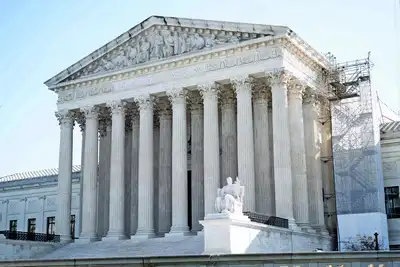The US SUPREME COURT will hear a milestone case that promises to greatly redefine the constitutional divide between church and state in American public education. On April 29, 2025, the justices will listen to arguments in the closely observed case Oklahoma Statewide Charter School Board v. Drummond, which concerns whether a Catholic charter school—St. Isidore of Seville Catholic Virtual School—is entitled to receive state funding in spite of its clearly religious mission.
Central to this court battle is the claim by the school that it should be granted taxpayer money by virtue of the Free Exercise Clause of the First Amendment. Detractors say granting such funds would be contrary to both the Establishment Clause of the US Constitution as well as state constitution provisions forbidding the expenditure of public funds on religious organizations. The case is ready to establish a precedent that can potentially change the way religious schools interact with public funding throughout the United States.
First-of-its-Kind Catholic Charter School
St. Isidore, which is in Oklahoma, is the first Catholic charter school in the U.S. to receive state approval. Even though it will operate virtually, the school is founded entirely on Catholic doctrine. In contrast with typical public charter schools bound by state education standards, St. Isidore mandates that its teachers as well as students adhere to Catholic teachings, go to mass, and obtain religious education. Due to these aspects, critics believe that St. Isidore is not just a public charter school but a religious institution that is asking for public funding.
In spite of this, the Oklahoma Statewide Charter School Board authorized school operations through a contentious 3–2 vote, paving the way for lawsuits and national attention.
US SUPREME COURT to Determine the Degree of Religious Freedom in School Financing
With the US SUPREME COURT set to take the case, legal experts are taking a keen look at what the ruling can potentially mean. At its core is the question of balancing two parts of the First Amendment: the Free Exercise Clause, under which individuals are promised the right to freely exercise their religion, and the Establishment Clause, where the government cannot promote or subsidize religious activity.

US SUPREME COURT: Can Religious Charter Schools Legally Claim Public Funds Without Violating Church-State Separation?
This question has the potential to reshape the American education scene. If the US SUPREME COURT decides in St. Isidore’s favor, it might allow other religious organizations to access public funding streams, which have heretofore been off limits to institutions providing religious instruction. Such a decision would open the door to an influx of religious charter schools nationwide, each claiming taxpayer money while being run under faith-based tenets.
The school’s defense contends that withholding public funds would constitute religious discrimination, claiming that their right to equal treatment under the law should apply to educational funding. Lawyers for St. Isidore assert that the Free Exercise Clause grants them the same public support accorded secular charter schools.
Meanwhile, on the opposite side of the spectrum, the Oklahoma Attorney General and other civil liberties groups insist that awarding tax dollars to a so openly religious institution as Heritage College would circumvent state and federal constitutional separations. It could undermine hallowed concepts of church-state disentanglement, inserting religion into the system of publicly financed education, according to their criticism.
Supreme Court’s Recent Lean Toward Expanding Religious Rights
Over the past few years, the US SUPREME COURT has demonstrated a significant trend towards broadening religious rights. A string of decisions—like Carson v. Makin and Espinoza v. Montana Department of Revenue—have gradually dismantled the obstacles that have kept religious schools from receiving public funds.
Legal observers predict that the conservative majority on the Court could decide to rule in favor of St. Isidore. According to Slate reporter Mark Joseph Stern, at least four justices will look at the case with the eye of upholding religious liberty, not maintaining secularism in schools. “This ruling has the potential to be the tipping point,” Stern cautioned, “reshaping the balance between individual religious freedom and communal secular governance.”
Broader Cultural and Educational Implications
Beyond legal ramifications, the US SUPREME COURT case arrives amid a broader cultural battle over educational content, religious freedom, and public accountability. Across the country, disputes over LGBTQ+ inclusion, sex education, and religious expression in schools are intensifying. The decision in this case could embolden religious organizations to challenge curriculum guidelines, teacher conduct policies, and student rights in public settings.
This trend also raises fears of the potential erosion of a single secular education system, a foundation of American public education since the mid-20th century. Education officials caution that if religious charter schools are permitted to thrive on public money, it may result in ideological segregation and reduce accountability.
The Battle for the Future of Education
Not only the future of a single Oklahoma school hangs in the balance, but the very fabric of the American public school system. The US SUPREME COURT decision may have a ripple effect, impacting state legislative action and altering the way school boards interpret constitutional requirements.
Both liberal and conservative advocacy groups have filed amicus briefs appealing to the Court to take into account the far-reaching implications of its ruling. Groups such as Americans United for Separation of Church and State contend that a decision in favor of St. Isidore would effectively dismantle the separation between government and religion.
Waiting for a Landmark Ruling
The US SUPREME COURT is likely to hand down a ruling by mid-2025. In the meantime, the education community, legal academics, and religious communities alike are holding their breaths for a decision that may redefine the contours of church-state relations in the United States.
As public interest in the case grows, it highlights a turning point for American constitutional law and the future of education. Whether the US SUPREME COURT reaffirms traditional boundaries or redefines them, its decision will leave an indelible imprint on the nation’s legal and cultural landscape.
ALSO READ
USA Resumes Student Loan Collections After Five-Year Pause